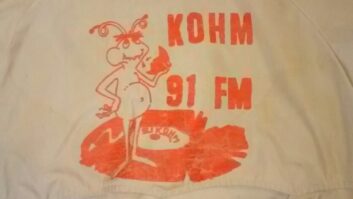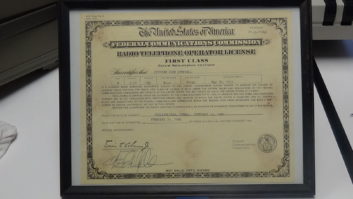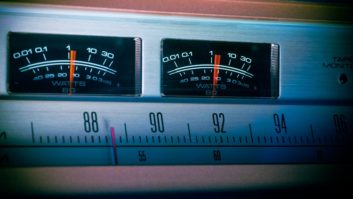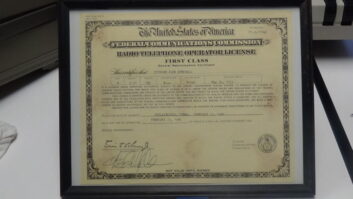Pictures Worth a Thousand Words

It was great seeing John Schneider’s photo of WJJD(AM) (“50 Kilowatts at WJJD,” Feb. 1). I worked there from 1961–63 as summer boardman replacement and it was one of the most fun jobs I had.

The attached pictures show:
1) First Phone license in 1958, with Walt Myer’s signature (later, Herman Gunther).
2) The Michigan Avenue studios, abandoned in 1961, and an announcement booth built right in front of the BTA-50F.

3) “Patch” Swanson — W9DRM, if I remember correctly — in front of the disabled transmitter control console, now stashed in front of the phasor for the three-antenna array, and Reese Rickards at the Ampex 350, recording a news insert right in front of the transmitter.
Sometime after 1963, the station moved a mile down Ballard Road and got a BTA-50H.
John Staples, W6BM
Lawrence Livermore Laboratories
Livermore, Calif.
WJJD and Skywave
I enjoyed John Schneider’s piece concerning WJJD.
I do believe that their license was “L” for limited, rather than “D” for daytime-only, in 1947.
WJJD would operate into the evening, signing off at sundown in Salt Lake City, rather than sundown at Chicago. This gave them extensive sporadic skywave service into the eastern part of the nation. At times, they would also sign on at a pre-dawn hour, perhaps paralleling a late-night signoff at Salt Lake City by KSL.
In those days, only a few stations maintained a 24-hour schedule.
WJJD used the skywave hours, especially, to “direct sell” to listeners with such products as “Motor-Cure” and music lessons on the guitar from “Jim Major” or the piano from “Dave Minor.”
The history of a few of the old timey clear channel and clear channel time-limited stations is interesting as they made their living “per inquiry” (essentially commission on the number of mail-in response-orders) during nighttime hours, while the affiliates of the “Big Four” networks made their way with daytime 15-minute, five-per-week soap operas and 2-1/2 hours of half-hour and hour big production programs in the evening hours.
E. Harold Munn Jr.
Retired Engineering Consultant
Munn-Reese Inc.
Parma, Mich.
John Schneider replies: Thank you for your comments about WJJD and what they programmed. You are correct that the WJJD license was limited by KSL, and so they enjoyed some extra operating hours.
Some Folks Are Still Non-Computerized!
When the notion of streaming was first circulated, the thought of taking the best programming in the country and reaching beyond where 1,000 Watts during the day can take you made us just giddy with anticipation.
But like Porter Wagoner sang, we soon saw the cold hard facts of life.
In the backside of nowhere, it is almost impossible to monetize the stream (“Reese: ‘Unreasonable’ Royalties Need to Go,” Jan. 2). So it’s all about proving that what we do is better than the plastic stations in the big markets that we’re not in yet but could be by streaming.
The dirty little secret is that there is more to this than just how much money we can throw at it to prove an idea.
We could accept the streaming companies’ prices. The royalties are a bit iffy. The killer is the bureaucratic nightmare of reporting. As I understand, Sound Exchange is requiring that I log every song over a two-week period, every quarter, and do it electronically. If you are not a computer-run station with all music uploaded along with appropriate info, this is a nightmare. We are live radio and still play music from CDs, LPs, 45s and, yes, even some 78s. It is quite free-form, deciding what to play next.
Simply put, radio being done like it was in the ’60s does not fit the computer, and streaming requires you to be computerized. And as Mr. Reese says, there is no way this can pay for itself.
Jim Jenkins
Owner and General Manager
WAGS(AM)
Bishopville, S.C.
Memories of Earl Bullock
Earl Bullock passed away in January. Here, an old colleague recalls his feisty spirit and unmatched work ethic.
It was 1979 when the Schafer automation system was delivered on five pallets to the local station in Pittsfield, Mass.
The next day, this fellow with a serious Texas accent showed up and we got to work. Earl liked to work and didn’t track his hours.
After spending the entire day and most of the night hauling and schlepping the racks, factory filled with reel to reels and Carousels, bolting them together and running cables, making carts with cue tones and loading tapes, adjusting 25 Hz detectors and playing with record levels, I was beat.
And I was a young man in 1979.
“Earl are you hungry?” I said. “There’s this place up the street called the Rainbow Room with outstanding lasagna, but it closes at 9 …”
He replied, “No, thanks. I ate yesterday and I’m still good.”
“Well then, I’m heading to Dunkin’ Donuts for a coffee and bagel. Can I bring you back something?”
“No, thanks. Don’t take too long! I want to show you some things …”
“OK, see you in a few!”
In less than 10 minutes, I had returned.
“Where the devil have you been?” he demanded. “What in tarnation took forever?”
“Uh, well I, uh …”
“Didn’t they learn you? Didn’t they teach you? Time is money!”
“Uh, well …”
“Well nothing, mister! We got lots to do here. No time for dogging it!”
“Sorry. I just had to eat something …”
“Okay, but time is money and don’t ever forget that!”
“Okay, Earl. Are the tape dead rolls set right?”
“The dead rolls are set but we need to do a real test.”
“A REAL test?”
“Yessir! We program it and let ’er rip for several hours to make sure everything functions.”
“OK, but it’s getting a little late and … ”
“You think it’s late? It’s early! It’s not even midnight!”
“When do you think we’ll get outta here?”
“I think we can wrap up this first phase by 3 a.m. Easy.”
“If this works, what do we have left to do?”
“Two more days of work. I’m being paid for three days and I’m only on day one.”
(Now, I don’t mind work, and this was interesting stuff; but after 16 hours I just had to ask … )
“Earl, how long is a day?”
“One thousand, four hundred and forty minutes,” he replied.
“Geez, I never heard it stated like that.”
“Well there’s a slot available for each minute of the day in the Schafer, a total of 1,440.”
“How do we program two things in the same minute if there’s only a slot for each minute?”
“We link them together and they play in sequence.”
“What happens when I push the ‘STEP’ button?”
“It advances to the next event. You should never have to push the step button unless it’s an emergency.”
“What happens when the tape runs out?”
“It C loops and advances to the next event.”
“What happens if that tape runs out?”
“It C loops and advances to the next event.”
“What happens when all the reels run out?”
“It C loops and advances to the next event and will do that until a valid event is encountered. You can monitor C loop activity right here on TP4 with a scope …”
“What happens if there are no valid events for a while?”
“Well then. I’d say your station has people problems! And as far as I know, there are no technical solutions to political problems.”
That phrase has stuck with me ever since: “There are no technical solutions to political problems.”
How true.
Thanks, Earl Bullock, for all you gave to the industry and to many of us personally.
Daniel Kelleher
Chief Engineer/IT Director
WSRS(FM), WTAG(AM)
Paxton, Mass.
Some More Oldies-But-Goodies for Your Bathroom Breaks
In response to Joe E. Lasmane’s humor piece, “How About a Little Bathroom Humor” (Jan. 2): Here are a few more of those GTBRs, as I call them (“Go To Bathroom Records”) from before the automation days.
“Lyin’ Eyes” by The Eagles, at about 6:20.
“Those Were the Days” by Mary Hopkin, at just over 5:00 (though why anyone would want to play that, except to go to the bathroom, I don’t know).
And “The Wreck of the Edmund Fitzgerald,” by Gordon Lightfoot, at just over 6:00.
The problem with longer songs is that they give people who don’t like them a longer time to switch stations. (Just a side note.)
At one country station in Savannah, Ga., where I did overnights, music was all on discs and we made a special bathroom tape.
I would go into the production room and put together a reel (we all remember those, right?) of about 15 minutes of songs and commercial jingles.
I would update it about every two to three weeks to reflect current musical taste.
As I hit my 60th birthday (and more than 40 years in the business), some other tidbits got passed along.
Looking back, it amazes me how some Class IVs lasted as long as they did.
It was a phenomenal job by programmers, same for those that went directional and missed half the city at night, and let’s not forget there were some daytimers that did very well in the AM heyday.
If you remember half-hour meter readings, six-hour live weekend air shifts and “cue burns,” you have been around for a while.
Stu Wright
Morning Personality
WORG(FM)
Orangeburg, S.C.
Burt Fisher Counters
I was not surprised by the response Radio World received to my comments on ham radio (Reader’s Forum, Jan. 2 issue). They were well written and I am unable to equal their prose; however, that does not make me wrong.
When you challenge hams, they will defend their privilege until their dying CQ. To borrow a phrase, “I’ll give you my ham rig when you pry (or take) it from my cold, dead hands.”
Some pointed out that many of the technological innovations over the past 80 years have been developed by hams. Marconi is long dead and vacuum tubes are somewhat out of style. Hams have done little for technology in the past 40 years.
Many in broadcast station operations did get a start in ham radio (me for one, in 1959). But young people are not getting into ham radio like they were 40 or 50 years ago. It is 1959 no longer. The average ham in 1960 was 28 years old. Today, the average ham is over 60.
Instead of high school ham radio clubs, we will be setting them up in nursing homes.
Hams do volunteer for emergency/public service communications, but probably by less than 1 percent. Most have no generator and few are physically fit enough to not be in the way of first responders.
G. Daniel Thomas, KB1WFF, paraphrased the Bob Dylan song in his letter to Radio World, “The Times They Are A-Changin’”: “If you can’t lend a hand, then get out of the way.”
Most hams today are in the way.
The hams now entering the broadcast profession do not have the same background required years ago. Even if they did, they will not get the same kind of radio experience novices had 50 years ago.
I did get several emails in response to the response I received, which was published in Radio World.
These (more supportive) hams did not want to be identified, fearing retribution from the other hams that just have to be right.
Comments included:
•“I felt the need to convey support to you personally, because your message was so resonant. I sense we are similar in that we love certain aspects of the hobby (not necessarily a ‘service,’ except in some rare circumstances by a few), but it’s not the way it used to be. I’m appalled at some of the operating practices and procedures I hear on the air these days — there has been a severe slipping of standards, training, ethics, manners, knowledge, sense of history — you name it.”
•“I was cracking up reading these dissertations of ‘The Value of Ham Radio’ by all these CEOs!”
•“Frankly speaking, I have met several hams in the last two years who are total jerks and, of course, plug-and-play operators.”
•“I totally agree with you that ham radio has gone through a lot of changes in the last 10 years!”
•“Unboxing a rig, running coax to a manufactured antenna and plugging in a mic.
“So what happens next? Pretty much the same thing, but with a bigger box for HF, maybe a bigger manufactured antenna. The rest is about the same. This is not preparing anyone for a job where you go out to the transmitter site and fix a bad contactor in the dog house.”
My point is not that hams are bad. They are not. They are generally of good character and intelligent.
The instances of doing good are not balanced by what little redeeming qualities hams provide. If you doubt, merely listen.
Hams have contests in which they lie about signal reports (these reports would be helpful, if true); they talk about minutia; there are frequencies with profanity and vulgarity; and, rather than learn the culture of other countries where the ham does speak English, they give those hams short shrift.
This started with Dan Thomas’ enthusiastic letter to the editor, singing the praises of ham radio. I responded, the multitudes responded and now I must simply QSB (fade) away.
Burt Fisher
Chief Engineer
WCCT(FM)
Sandwich, Mass.










